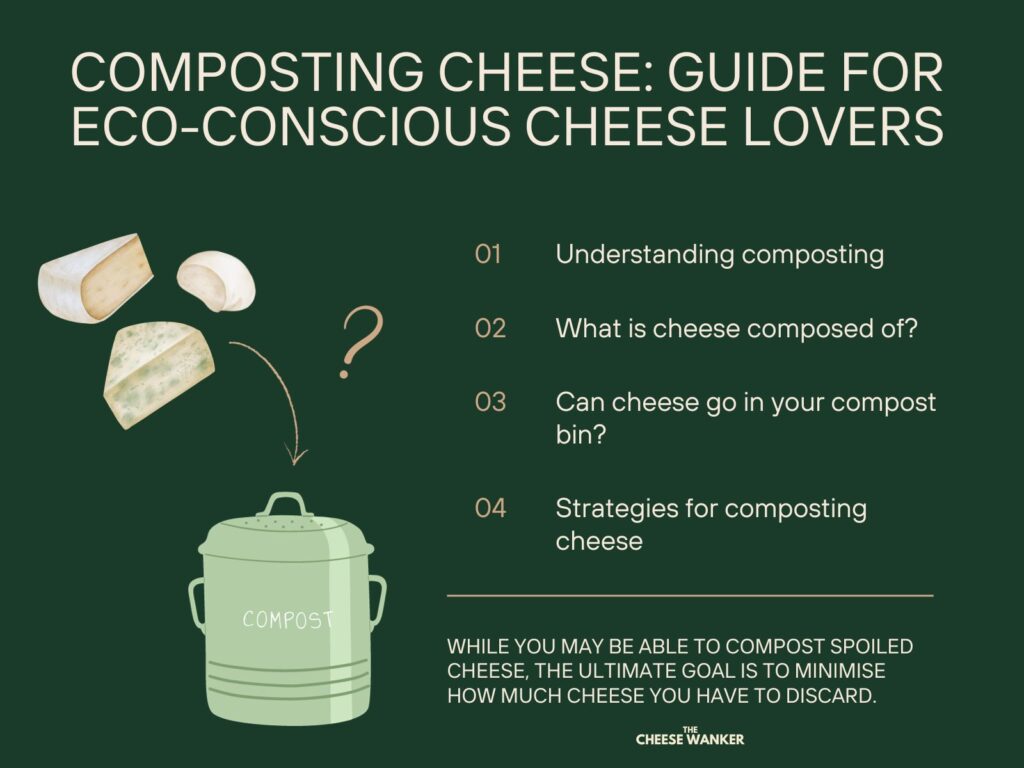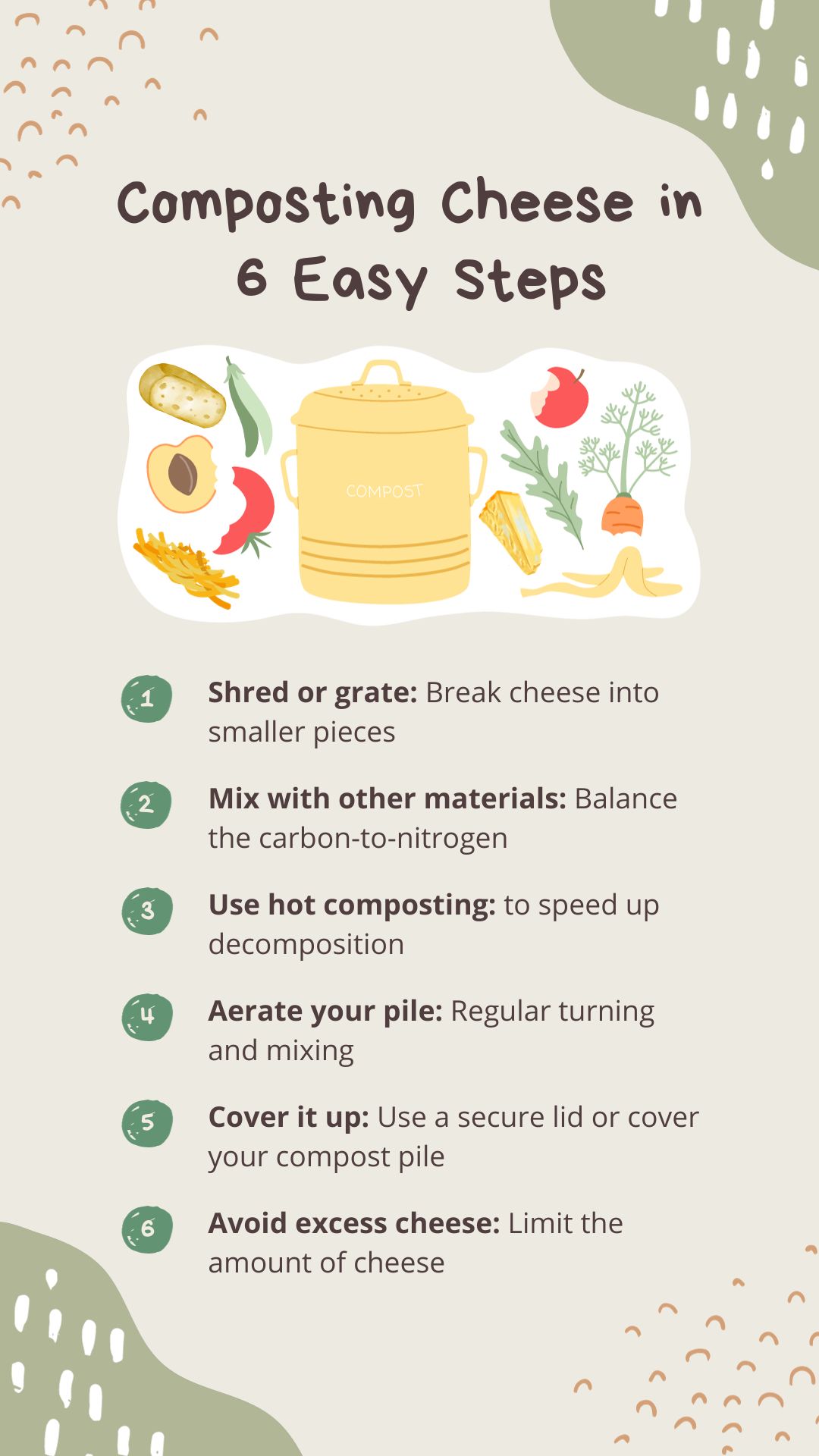Composting has become a cornerstone of sustainable living, offering an eco-friendly way to reduce waste and nourish our gardens. One item that often raises questions is cheese. Can cheese be composted effectively, or does it pose challenges that can disrupt your compost pile? In this comprehensive guide, we will explore the ins and outs of composting cheese.

Understanding composting
Before diving into the world of cheese composting, let’s briefly review the fundamentals of composting.
Composting is the natural process of breaking down organic matter into nutrient-rich soil.
It involves three key elements: greens (nitrogen-rich materials), browns (carbon-rich materials), and water. These elements work together with microorganisms to transform waste into black gold for your garden.
What is cheese composed of?
Cheese, a beloved dairy product worldwide, is a rich source of fat, protein, and calcium. It’s a delicious addition to countless dishes, but its composition raises concerns when it comes to composting.
Cheese contains high levels of fat and protein, which can make it a tricky addition to your compost pile. The slow decomposition of cheese, combined with its potential to attract pests and create unpleasant odours, makes it a less-than-ideal candidate for composting.
Can cheese go in your compost bin?
So, can you compost cheese? The answer is both yes and no.
While cheese can technically be composted, it requires careful consideration and management due to its unique characteristics. The high fat content can slow down decomposition, leading to a longer composting process.
Additionally, cheese can attract unwanted critters and create foul odours if not managed properly.
Strategies for composting cheese
If you’re determined to compost cheese, here are some strategies to make the process more successful:
- Shred or grate: Breaking cheese into smaller pieces increases its surface area, promoting faster decomposition.
- Mix with other materials: Balance the carbon-to-nitrogen ratio by combining cheese with ample browns (e.g., dried leaves, newspaper).
- Use hot composting: Employ a hot composting method to speed up decomposition and minimise odours.
Managing compost pile odours and pests
To prevent your cheese-containing compost pile from becoming a pest magnet or a smelly mess, remember to:
- Aerate your pile: Regular turning and mixing will help maintain proper airflow and prevent odours.
- Cover it up: Use a secure lid or cover your compost pile to deter pests.
- Avoid excess cheese: Limit the amount of cheese you add to your compost pile to reduce the risk of complications.
Tips to prevent cheese wastage
While you may be able to compost spoiled cheese, the ultimate goal is to minimise how much cheese you have to discard. With that in mind, here are some great tips on how to prevent cheese wastage.
Buy smaller portions: If you find that you often have leftover cheese, consider buying smaller portions. This reduces the chance of cheese going bad before you can use it up.
Proper wrapping: Wrap cheese in wax paper or aluminium foil, and then store in airtight containers or drawers. This prevents moisture loss and helps maintain freshness.
Temperature control: Keep cheese in the refrigerator at the right temperature. Different types of cheese require different storage temperatures, so consult specific guidelines. Generally, store cheese at 1°C to 7°C (35°F to 45°F).
Label and date: When storing cheese in the refrigerator, label and date it. This helps you keep track of its freshness.
Properly seal opened packages: If you’ve opened a package of sliced or shredded cheese, make sure to reseal it tightly. Consider transferring it to a resealable bag for better preservation.
Use cheese rinds: Many cheese rinds (e.g., Parmigiano Reggiano) are edible and add flavour to dishes like soups and stews. Don’t discard them; include them in your cooking.
Plan meals: Plan your meals to incorporate cheese to avoid buying more than you can use. Think about using cheese in sandwiches, salads, omelettes or pasta dishes.
Rotate stock: When you buy cheese, try to use older cheese first to prevent it from ageing too much and becoming unusable.
Conclusion
In conclusion, composting cheese is possible but comes with its fair share of challenges. The high fat content, slow decomposition, and potential for odours and pests require careful management.
If you’re committed to reducing food waste through composting, consider incorporating cheese in small quantities, taking care to follow the strategies mentioned earlier.
Are you ready to take action? Start or improve your composting efforts today! Share your thoughts, questions, or experiences with cheese composting in the comments below.

